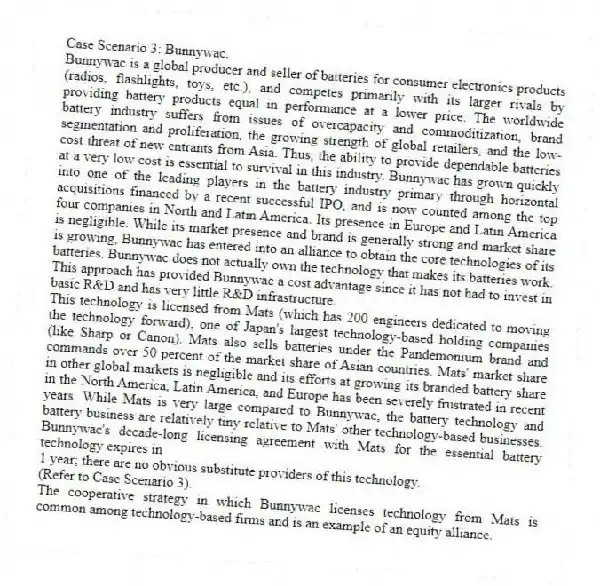
Case Scenario 3: Bunnywac.
Bunnywac is a global producer and seller of batteries for consumer electronics products (radios, flashlights, toys, etc.), and competes primarily with its larger rivals by providing battery products equal in performance at a lower price. The worldwide battery industry suffers from issues of overcapacity and commoditization, brand segmentation and proliferation, the growing strength of global retailers, and the low-cost threat of new entrants from Asia. Thus, the ability to provide dependable batteries at a very low cost is essential to survival in this industry. Bunnywac has grown quickly into one of the leading players in the battery industry primary through horizontal acquisitions financed by a recent successful IPO, and is now counted among the top four companies in North and Latin America. Its presence in Europe and Latin America is negligible. While its market presence and brand is generally strong and market share is growing, Bunnywac has entered into an alliance to obtain the core technologies of its batteries. Bunnywac does not actually own the technology that makes its batteries work. This approach has provided Bunnywac a cost advantage since it has not had to invest in basic R&D and has very little R&D infrastructure.
This technology is licensed from Mats (which has 200 engineers dedicated to moving the technology forward), one of Japan's largest technology-based holding companies (like Sharp or Canon). Mats also sells batteries under the Pandemonium brand and commands over 50 percent of the market share of Asian countries. Mats' market share in other global markets is negligible and its efforts at growing its branded battery share in the North America, Latin America, and Europe has been severely frustrated in recent years. While Mats is very large compared to Bunnywac, the battery technology and battery business are relatively tiny relative to Mats' other technology-based businesses. Bunnywac's decade-long licensing agreement with Mats for the essential battery technology expires in
1 year; there are no obvious substitute providers of this technology.
-(Refer to Case Scenario 3).
The cooperative strategy in which Bunnywac licenses technology from Mats is common among technology-based firms and is an example of an equity alliance.
Correct Answer:
Verified
Q110: Identify the competitive risks associated with cooperative
Q114: Why are cooperative strategies often used when
Q133: Case Scenario 2: ERP Inc
ERP, Inc., (ERPI)is
Q135: Case Scenario 1: Norning International
Norning International (NI)states
Q136: Case Scenario 2: ERP Inc
ERP, Inc., (ERPI)is
Q138: Case Scenario 1: Norning International
Norning International (NI)states
Q139: Case Scenario 1: Norning International
Norning International (NI)states
Q140: Case Scenario 1: Norning International
Norning International (NI)states
Q142: Case Scenario 3: Bunnywac.
Bunnywac is a global
Q143: Case Scenario 3: Bunnywac.
Bunnywac is a global
Unlock this Answer For Free Now!
View this answer and more for free by performing one of the following actions

Scan the QR code to install the App and get 2 free unlocks

Unlock quizzes for free by uploading documents